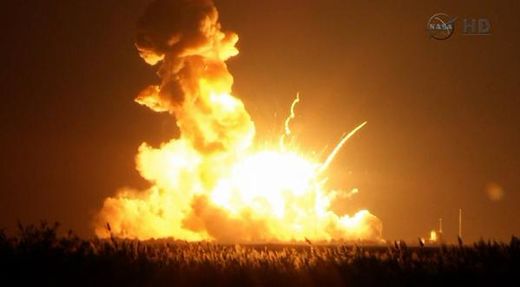Russian deliver space station cargo after US flop
The company behind the dramatic launch explosion of a space station supply mission promises to find the cause of the failure and is warning residents to avoid any potentially hazardous wreckage.
Orbital Sciences Corp.'s unmanned rocket blew up just moments after liftoff Tuesday evening from the Virginia coast.
Meanwhile, early Wednesday, the Russian Space Agency launched its own cargo vessel from Kazakhstan and the spacecraft arrived at the International Space Station six hours later with 3 tons of food. The smooth flight was in stark contrast to the Orbital Sciences' failed launch, and had been planned well in advance of the accident.
The Orbital Sciences rocket was carrying a capsule loaded with 2 1/2 tons of space station experiments and equipment for NASA. No one was injured when the rocket exploded moments after liftoff, shooting flaming debris down onto the launch area and into the ocean.
Ground crews were ready to access the fire-stricken area of NASA's Wallops Flight Facility at daybreak Wednesday to search for accident debris.
The company's cargo ship was carrying 5,000 pounds of experiments and equipment for NASA, as well as prepackaged meals and, in a generous touch, freeze-dried Maryland crabcakes for a Baltimore-born astronaut who's been in orbit for five months.
All of the lost materials will be replaced and flown to the 260-mile-high space station, NASA's station program manager Mike Suffredini said. The six-person space station crew has enough supplies to last well into spring.
The accident is sure to draw scrutiny to the space agency's growing reliance on private U.S. companies in the post-shuttle era. NASA is paying billions of dollars to Virginia-based Orbital Sciences and the California-based SpaceX company to make station deliveries, and it's counting on SpaceX and Boeing to start flying U.S. astronauts to the orbiting lab as early as 2017.
It was the fourth bound for the orbiting lab; the first flew just over a year ago. SpaceX is scheduled to launch another Dragon supply ship from Cape Canaveral, Florida, in December.
"Today's launch attempt will not deter us from our work to expand our already successful capability to launch cargo from American shores to the International Space Station," NASA's human exploration chief, Bill Gerstenmaier, said in a statement following the accident.
Until Tuesday, all of the supply missions by Orbital Sciences and SpaceX had been near-flawless.
President Barack Obama has long championed this commercial space effort. He was in Wisconsin for a campaign rally and was kept informed.
Orbital Sciences' executive vice president Frank Culbertson said the company carried insurance on the mission, which he valued at more than $200 million, not counting repair costs. The explosion hit Orbital Science's stock, which fell more than 15 percent in after-hours trading.
John Logsdon, former space policy director at George Washington University, said the explosion was unlikely to be a major setback to NASA's commercial space plans. But he noted it could derail Orbital Sciences for a while given the company has just one launch pad and the accident occurred right above it.
At a news conference Tuesday night, Culbertson and others said everyone at the launch site had been accounted for and the damage appeared to be limited to the facilities.
He noted that the cargo module was carrying hazardous materials and warned residents to avoid any contact with debris.
"Certainly don't go souvenir hunting along the beach," he said.
Things began to go wrong 10 to 12 seconds into the flight and it was all over in 20 seconds when what was left of the rocket came crashing down, Culbertson said. He said he believes the range-safety staff sent a destruct signal before it hit the ground, but was not certain.
This was the second launch attempt for the mission. Monday evening's try was thwarted by a stray sailboat in the rocket's danger zone. The restrictions are in case of just such an accident that occurred Tuesday.
Culbertson said the top priority will be repairing the launch pad "as quickly and safely as possible."
"We will not fly until we understand the root cause," he said, adding that it was too early to guess how long it might take to make the rocket repairs and fix the launch pad. It will take a few weeks, alone, to assess the damage and extent of potential repairs.
Culbertson also stressed that it was too soon to know whether the Russian-built engines, modified for the Antares and extensively tested, were to blame.
"We will understand what happened - hopefully soon - and we'll get things back on track," Culbertson assured his devastated team. "We've all seen this happen in our business before, and we've all seen the teams recover from this, and we will do the same."
The Wallops facility is small compared to NASA's major centers like those in Florida, Texas and California, but vaulted into the public spotlight in September 2013 with a NASA moonshot and the first launch to the space station.
Michelle Murphy, an innkeeper at the Garden and Sea Inn, New Church, Virginia, where launches are visible across a bay about 16 miles away, saw the explosion.
"It was scary. Everything rattled," she said. "There were two explosions. The first one we were ready for. The second one we weren't. It shook the inn, like an earthquake. It was extremely intense."
Among the instruments that were lost from the cargo module: a meteor tracker and 32 mini research satellites, along with numerous experiments compiled by schoolchildren.
The two Americans, three Russians and one German on the orbiting space station were watching a live video feed from Mission Control and saw the whole thing unfold, Suffredini said.



0 reacties:
Post a Comment